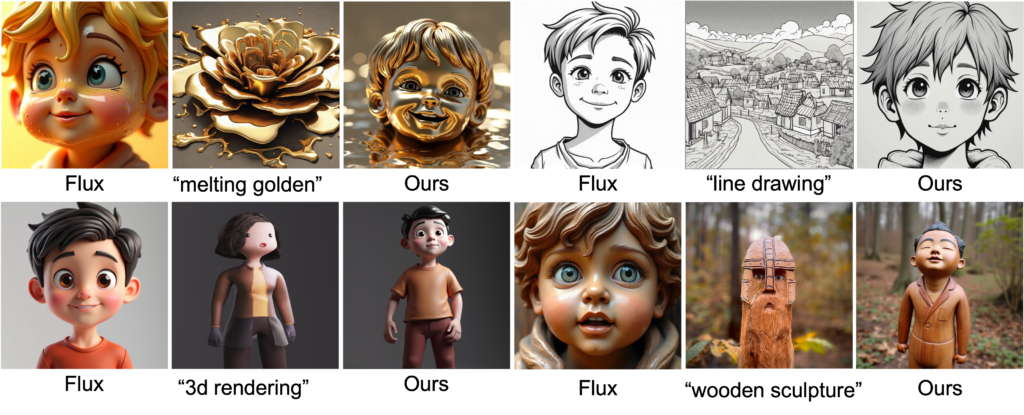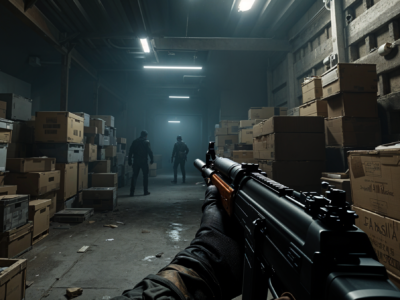Well, this is going to be a bit technical, but if you’re interested in generative AI and you’re going to be editing images, hang on tight. We can see that image editing with AI is exploding (Adobe Firefly and other tools that deliver spectacular results come to mind); But we’re also seeing the arrival of new, increasingly specialized models, capable of transforming visuals with impressive precision.
Among these new technologies, Google RF-Inversion will make image editing even more accessible and rapid.
Listen to the AI podcast :
In contrast to popular broadcast models, RF-Inversion takes a unique approach to achieving high-fidelity results while offering great flexibility in editing.
What is RF-Inversion?
Basically, RF-Inversion is like a super digital drawing tool that understands what you want to do and helps you easily achieve it on your images.
How does it work?
Imagine you have a photo and you want to change it. RF-Inversion goes:
- Look closely at the image
- “Break it down” into smaller pieces
- Understands what’s in the image
- Then “recomposes” it by changing certain parts according to your instructions
What can we do with it?
With RF-Inversion, you can do lots of fun things:
- Change the style of an image (for example, turn a photo into a cartoon)
- Modify specific elements in the image (such as change the color of a car)
- Add or remove things in the image
Why is this cool?
RF-Inversion has several advantages:
- It’s easy to use, even if you’re not a computer expert
- You can make lots of different changes to an image
- The modified image remains realistic and of good quality
Read our article to understand the basic concepts for artificial intelligence image generation: AI Image Generators: Exploring the Key Principles
The benefits of RF-Inversion
The power of RF-Inversion rests on several key advantages that make it a leading technology for image editing:
Unprecedented fidelity
Compared with broadcast models (DM), RF-Inversion offers better fidelity to the original images, even when the latter are corrupted or altered.
This means that important details of the original image are preserved, even during modification or restoration operations.
Simplified editing
Thanks to the use of text prompts, editing becomes much more intuitive and accessible, even for non-expert users.
In contrast to more complex techniques such as inpainting, where specific knowledge of image editing is often required, RF-Inversion makes the process easy, allowing anyone to modify an image simply via text instructions.
Efficiency and speed
RF-Inversion also stands out for its rapidity.
In contrast to diffusion models that use an inverse SDE (stochastic differential equation), RF-Inversion relies on an inverse ODE, making the process more efficient.
Furthermore, no additional optimization of latent variables is required, resulting in faster results.
Applications and potential of RF-Inversion
Thanks to its flexibility and efficiency, RF-Inversion finds applications in many fields, from artistic creation to the restoration of old images.
Here are a few concrete examples of use:
Generating images from simple strokes
RF-Inversion transforms simple sketches or strokes into photorealistic images.
This is a major breakthrough for artists or designers who want to quickly test different visual ideas without having to go through a tedious creative process.
Face editing
Changing age, gender, or adding accessories to a face becomes simple with RF-Inversion.

These changes can be made while preserving the identity and distinctive features of the original face.
Inserting objects into an image
This technology enables objects to be inserted into an existing image in a consistent manner.
For example, it becomes possible to add an element to a scene while respecting the shadows, perspectives and lighting of the original image.
Stylization and style transfer
RF-Inversion also excels in the field of style transfer, where the visual style of one image can be applied to another.

This opens up endless creative possibilities, especially for artists and content creators.
Potential in the creative industry and beyond
The applications of RF-Inversion are not limited to technical tasks. Its potential goes far beyond, touching many sectors:
- Art creation: RF-Inversion allows artists to test variations, new styles and visual concepts with consummate ease, ushering in a new era of digital creations.
- Advertising and design: Marketing professionals can use this tool to quickly adjust product images or create striking visuals without the need to redo entire photo shoots.
- Image restoration : Specialists in the restoration of old or damaged images will find RF-Inversion a powerful tool for reconstructing and enhancing photos while respecting their visual integrity.
RF-Inversion promises to be a revolutionary technology in image editing, thanks to its ability to combine precision, speed and ease of use.
Its potential is immense, ranging from artistic creation and image restoration to commercial applications in design and advertising.
AI NEWSLETTER
Stay on top of AI with our Newsletter
Every month, AI news and our latest articles, delivered straight to your inbox.

CHATGPT prompt guide (EDITION 2024)
Download our free PDF guide to crafting effective prompts with ChatGPT.
Designed for beginners, it provides you with the knowledge needed to structure your prompts and boost your productivity
With this ebook, you will:
✔ Master Best Practices
Understand how to structure your queries to get clear and precise answers.
✔ Create Effective Prompts
The rules for formulating your questions to receive the best possible responses.
✔ Boost Your Productivity
Simplify your daily tasks by leveraging ChatGPT’s features.
Similar posts
AI Image Generators: Exploring Key Principles
Thanks to spectacular advances in the fields of deep learning and neural networks, tools such as Midjourney or Dall-E make it possible to create stunning images from simple text descriptions. …
DIAMOND : Microsoft’s revolutionary AI video game engine
The field of video games has always been fertile ground for innovation, but the rise of AI promises to disrupt this universe even further. Today, one of the most fascinating …
Flux 1.1 pro: A faster model with even more realistic AI images
The line between reality and fiction is becoming increasingly blurred thanks to constant advances in the field of artificial intelligence image generation. Black Forest Labs has just launched its new …


